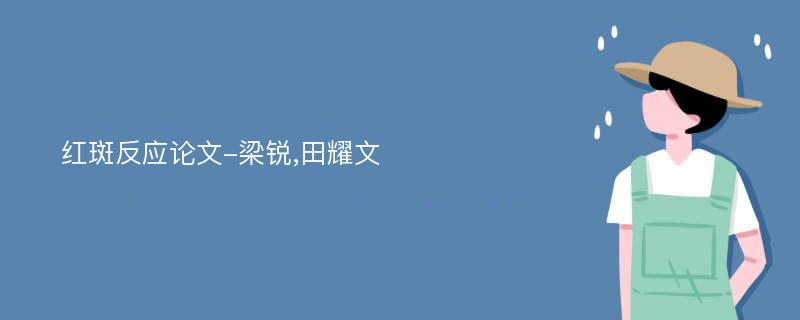
导读:本文包含了红斑反应论文开题报告文献综述及选题提纲参考文献,主要关键词:麻风病,结节性红斑,沙利度胺,疗效观察
红斑反应论文文献综述
梁锐,田耀文[1](2009)在《沙利度胺治疗反复发生性麻风结节性红斑反应的疗效观察》一文中研究指出麻风结节性红斑(ENL)是Ⅱ型麻风反应的主要临床表现,在Coombs分类中属Ⅲ型超敏反应。常见于LL、BL患者,在治疗中有部分患者反复发生、屡治不愈。甘肃省两当疗养院运用沙利度胺治疗这类患者的近期和远期疗效均基本满意,现将临床资料基本齐全的20例患者的疗效观察报告如下。(本文来源于《地方病通报》期刊2009年06期)
李丽娜,万慧颖,冉玉平[2](2008)在《瘤型麻风结节性红斑反应误诊1例》一文中研究指出临床资料患者男,44岁。因反复全身结节红斑3年,伴发热1年半就诊。3年前患者无明显诱因全身出现结节红斑,以四肢为主,局部肿胀、压痛,红斑可相互融合成片,疹间皮肤正常,红斑消退后有褐色色素沉着。1年半前患者双下肢出现结节红斑,约花生大,3~4天后伴高热,最(本文来源于《中国麻风皮肤病杂志》期刊2008年09期)
王成传,杨芳,于洪涛[3](2007)在《兴城矿泉浴对紫外线红斑反应的影响》一文中研究指出目的了解矿泉浴前后照射紫外线对红斑反应的影响,为紫外线集中时间治疗提供方便。方法选择健康成年人100名,男83名,女17名。年龄22~58岁,均排除神经性疾病和使用过影响光敏反应的药物。采用测量紫外线最小红斑量(MED)自体对照的方法。实验部位是下腹两侧对称区。左侧测定生物剂量后进行矿泉浴,作为观察组;右侧矿泉浴后测定生物剂量,作为对照组。结果紫外线照射前或照射后进行矿泉浸浴,对紫外线红斑反应和潜伏期均无明显影响。结论在安排紫外线照射治疗时,无需考虑矿泉浴的先后,为紫外线集中时间治疗提供了方便。(本文来源于《中国疗养医学》期刊2007年09期)
袁肖海,王学民,周玉田,吴佩兰,谈益妹[4](2007)在《皮肤对紫外线红斑反应敏感度的季节因素研究》一文中研究指出目的:比较春夏秋冬4个季节不同部位皮肤对紫外线红斑反应的敏感性,了解皮肤紫外线红斑反应敏感度的影响因素。方法:春夏秋冬4个季节分别在40名受试者的前臂伸侧(曝光部位)和上臂屈侧(非曝光部位)使用中波紫外线(UVB)(181.44、140.40、88.56、56.16mJ)及长波紫外线(UVA)+UVB(13.49J/364.80mJ,9.91J/273.60mJ,6.62J/190.00mJ,4.45J/125.40mJ)各4个剂量进行照射。照射前及照射后10min、24h、48h、第7天、第14天进行临床评分和使用Mexameter(皮肤黑素和血红素测定仪)进行检测,计算皮肤红斑指数改变率(EIR)。结果:①非曝光部位红斑反应强度在春季显着大于其他季节(P<0.05),与非曝光部位的四季皮肤基础色素情况完全一致,且具有相关性(P<0.05)。②春季和其他3个季节间曝光部位红斑反应强度差异均有统计学意义(P<0.05)。结论:四季中春季对紫外线红斑反应的敏感性最高。表皮中黑素含量会影响皮肤对紫外线的敏感性。(本文来源于《临床皮肤科杂志》期刊2007年03期)
邓向东,李世荣[5](2006)在《红斑反应与理想光子嫩肤术关系的研究》一文中研究指出目的观察红斑反应与理想光子嫩肤术的关系,为临床提供参考。方法采用34J/cm2的强脉冲光,对10只兔子(4个部位)分别照射1、2、3、4次,记录出现红斑反应的照射次数,术后第15天观察治疗部位切片,记录使皮肤真皮胶原蛋白增生的照射次数。结果红斑反应的阈刺激照射次数是(2.60±0.52)次,真皮胶原蛋白增生的阈刺激照射次数是(3.00±0.67)次。两者比较无显着差异。结论IPL致红斑反应的能量大小,与理想光子嫩肤术所需的能量接近。(本文来源于《中国美容整形外科杂志》期刊2006年06期)
邓向东,李世荣[6](2006)在《红斑反应与理想光子嫩肤术关系的研究》一文中研究指出目的观察红斑反应与理想光子嫩肤术的关系,为临床提供参考信息。方法用34J/cm2的强脉冲光对10只兔四个部位分别进行1、2、3、4次照射,记录出现红斑反应的照射次数,术后15天治疗部位切片观察,记录使皮肤真皮胶原蛋白增生的照射次数。结果红斑反应的闽刺激照射次数是(2.6±0.52) 次,真皮胶原蛋白增生的阈刺激照射次数是(3±0.67)次。两者统计学比较无显着差异。结论 IPL致红斑反应的能量大小与理想光子嫩肤术所需的能量接近。(本文来源于《第4届东方国际美容外科大会论文汇编》期刊2006-09-01)
Beattie,P.E.,Dawe,R.S.,Traynor,N.J.,焦婷[7](2006)在《摄入贯叶连翘生粉(金丝桃素)会增强患者在大剂量UVA1治疗过程中的红斑反应吗?》一文中研究指出Background: St John s wort (SJW) is widely used as a treatment for depression. A phototoxic reaction, due to its content of hypericin, can occur in animals and in cell culture, and has been reported in humans. Hypericin displays absorption within the ultraviolet (UV) A1 spectrum and there may therefore be a potential for phototoxicity if taken during high-dose UVA1 therapy. Objectives: To assess the phototoxicity risk of SJW ingestion. Methods: Eleven adult volunteers of skin types I and II were exposed to a geometric dose series of UVA1 irradiation from a high-output source (Dermalight Ultra 1; Dr H nle, Martinsreid, Germany; irradiance 70- 77 mW cm- 2) on the photoprotected lower back skin at eight 1.5-cm2 test areas. Irradiation was carried out at baseline and after 10 days of SJW extract 1020 mg (equivalent to 3000 μ g of hypericin) daily. Four, 8, 24 and 48 h after each exposure, the minimal erythema dose (MED) and the presence or absence of pigmentation were recorded visually and erythema was assessed objectively with an erythema meter. Results: The median MED and D0.025, an objective measure of MED, were lower at all time-points after SJW ingestion. The visual erythemal peak (lowest median MED), which was seen at 8 h postirradiation, was lower after SJW (median 14 J cm- 2, range 10- 56) than at baseline (median 20 J cm- 2, range 14- 56) (P = 0.047). Similarly, the median D0.025 at 8 h postirradiation was lower after SJW(median 22.0 J cm- 2, range 15.2- 53.9) than at baseline (median 33.7 J cm - 2, range 22.9- 136.0) (P = 0.014). The MED and D0.025 were also significantly different at the 48-h and 4-h time-points, respectively. Significance was not reached at the 24-h time-point. Median intensity of postirradiation erythema increased at all time-points after ingestion of SJW. Despite these differences, the maximum slope of the dose-response curve was not increased after SJW ingestion. Conclusions: These data suggest that SJW extract has the potential to lower the erythemal threshold to UVA1 irradiation in a significant proportion of individuals and highlight the importance of ascertaining a full drug history, including herbal remedies, before initiating UVA1 phototherapy.(本文来源于《世界核心医学期刊文摘(皮肤病学分册)》期刊2006年03期)
Leslie,K.S.,Lodge,E.,Garioch,J.J.,王琼[8](2005)在《窄波(TL-01)UVB引起身体各部位红斑反应的比较》一文中研究指出In most dermatology centres where phototesting is performed, the starting dose is calculated as a proportion of the minimal erythema dose (MED). Previous studies have found significant differences in MED readings between forearm and back skin with both broadband and narrowband (NB) UVB. Our objective was to compare MEDs obtained from three body sites, the forearm, back and abdomen, to see if there was a significant difference in individuals. We recruited 20 healthy volunteers who were exposed to our standard dose series for phototesting with NB-UVB to three body sites:forearm, back and abdomen. MEDs were assessed 24 h post exposure. The median MEDfor the abdomen was 0.79 J/cm2, the back 0.95 J/cm2 and the arm 1.11 J/cm2. Friedman's analysis of variance by ranks showed that these differences were significant (P=0.003). There was no correlation between skin type and MED for any of the three anatomical sites. Our results support phototesting for all patients prior to treatment with NB-UVB. Furthermore, we have shown that the abdomen is the anatomical site of choice for phototesting, as this will result in a reduced risk of burning episodes.(本文来源于《世界核心医学期刊文摘(皮肤病学分册)》期刊2005年09期)
Waterston,K,,Naysmith,L,,Rees,J[9](2005)在《紫外线和光适应的红斑反应的生理学改变》一文中研究指出We have studied the cutaneous response to ultraviolet radiation, measured objectively as erythema in a sample of 12 body sites on 15 Northern European subjects with multiple doses of ultraviolet B (UVB). Skin pigmentation and the development of photoadaptation in response to five repeated doses of irradiation at three body sites was also measured. We report striking differences of up to 5-fold at different body sites to the same challenge dose (P < 0.001) and demonstrate that for this population, site variation is just as important as between-person variation. Skin color at each body site is a strong predictor of response(P < 0.001)and that this cannot be attributed to vascular differences, but instead we believe it reflects site-specific variations in melanin pigmentation. We also observed similar but smaller within-person effects for responses to another inflammatory agent, dithranol (P < 0.01). Despite this, we did not find evidence for differences in the development of photoadaptation by body site. These results have clear clinical implications for the practice of phototesting prior to commencing phototherapy, for therapeutic failure in sites such as the legs in patients with psoriasis, and perhaps for melanoma body-site distribution.(本文来源于《世界核心医学期刊文摘(皮肤病学分册)》期刊2005年04期)
罗咏贤,陈耀明,何月娥[10](2005)在《紫外线红斑反应与季节的影响》一文中研究指出目的探讨紫外线红斑反应在季节变化上的差异。方法使用不同型号、不同产地的U型紫外线全光谱高压汞灯灯管测量最小红斑量(minimalerythemaldose,MED)值,灯距均采用50cm,所测部位均在患者的下腹部取样。结果在广州地区人体对紫外线敏感性在夏季显着增高,在冬季显着降低。结论在季节转换时,必须重测MED值,从而适应机体在季节中对紫外线敏感度的变化,达到准确使用治疗剂量。(本文来源于《中国临床康复》期刊2005年03期)
红斑反应论文开题报告
(1)论文研究背景及目的
此处内容要求:
首先简单简介论文所研究问题的基本概念和背景,再而简单明了地指出论文所要研究解决的具体问题,并提出你的论文准备的观点或解决方法。
写法范例:
临床资料患者男,44岁。因反复全身结节红斑3年,伴发热1年半就诊。3年前患者无明显诱因全身出现结节红斑,以四肢为主,局部肿胀、压痛,红斑可相互融合成片,疹间皮肤正常,红斑消退后有褐色色素沉着。1年半前患者双下肢出现结节红斑,约花生大,3~4天后伴高热,最
(2)本文研究方法
调查法:该方法是有目的、有系统的搜集有关研究对象的具体信息。
观察法:用自己的感官和辅助工具直接观察研究对象从而得到有关信息。
实验法:通过主支变革、控制研究对象来发现与确认事物间的因果关系。
文献研究法:通过调查文献来获得资料,从而全面的、正确的了解掌握研究方法。
实证研究法:依据现有的科学理论和实践的需要提出设计。
定性分析法:对研究对象进行“质”的方面的研究,这个方法需要计算的数据较少。
定量分析法:通过具体的数字,使人们对研究对象的认识进一步精确化。
跨学科研究法:运用多学科的理论、方法和成果从整体上对某一课题进行研究。
功能分析法:这是社会科学用来分析社会现象的一种方法,从某一功能出发研究多个方面的影响。
模拟法:通过创设一个与原型相似的模型来间接研究原型某种特性的一种形容方法。
红斑反应论文参考文献
[1].梁锐,田耀文.沙利度胺治疗反复发生性麻风结节性红斑反应的疗效观察[J].地方病通报.2009
[2].李丽娜,万慧颖,冉玉平.瘤型麻风结节性红斑反应误诊1例[J].中国麻风皮肤病杂志.2008
[3].王成传,杨芳,于洪涛.兴城矿泉浴对紫外线红斑反应的影响[J].中国疗养医学.2007
[4].袁肖海,王学民,周玉田,吴佩兰,谈益妹.皮肤对紫外线红斑反应敏感度的季节因素研究[J].临床皮肤科杂志.2007
[5].邓向东,李世荣.红斑反应与理想光子嫩肤术关系的研究[J].中国美容整形外科杂志.2006
[6].邓向东,李世荣.红斑反应与理想光子嫩肤术关系的研究[C].第4届东方国际美容外科大会论文汇编.2006
[7].Beattie,P.E.,Dawe,R.S.,Traynor,N.J.,焦婷.摄入贯叶连翘生粉(金丝桃素)会增强患者在大剂量UVA1治疗过程中的红斑反应吗?[J].世界核心医学期刊文摘(皮肤病学分册).2006
[8].Leslie,K.S.,Lodge,E.,Garioch,J.J.,王琼.窄波(TL-01)UVB引起身体各部位红斑反应的比较[J].世界核心医学期刊文摘(皮肤病学分册).2005
[9].Waterston,K,,Naysmith,L,,Rees,J.紫外线和光适应的红斑反应的生理学改变[J].世界核心医学期刊文摘(皮肤病学分册).2005
[10].罗咏贤,陈耀明,何月娥.紫外线红斑反应与季节的影响[J].中国临床康复.2005
